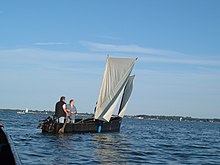Peat barge (Steinhude)
A Steinhuder Torfkahn is a traditional work boat on the Steinhuder Meer . There are also peat barges in other regions, some of which are very different.
description
The peat barge is still used today as a workboat for fishermen on the Steinhuder Meer. In earlier times, however, it was used for any transport on the lake, for example for the transport of peat from the Dead Moor in the east of the Steinhuder Meer, which was an important heating material until the 20th century .
The origin of this shipbuilding tradition is believed to be in the Middle Stone Age around 8000 BC. Starting from a dugout canoe , later several trees were put together and reinforced with a curb (transversely). Soon it was much easier to build the enlarged boats entirely from planks, so that the peat barge was created in its present form. Today's peat barges, which are around 9 meters long, consist of three to four 8 to 10 cm thick oak planks on which the planks are placed without the use of frames . On the floor, a solid triangular pointed oak block (wedge) is forward than Steven placed. The bulkhead, 50 cm high and 10 cm thick, is roughly in the middle of the ship . The rear end is formed by the 8 to 10 cm thick mirror bulkhead.
The ships with Sprietsegeltakelung were designed as "single-handed sailing ships " with two masts leaning forward . The front one directly on the stem, the second one with the larger mainsail in an iron eyelet on the center sowing (the bulkhead). Shrouds and stages are not yet required with a sail area of 7 to 8 m². The foresail is 4.5 to 5 m² in size. This results in a total sail area of 11.5 to 13 m². The peat barge has no sword . To reduce the drift , the ship is heeled while sailing , i. H. laid on its side.
When sailing without a sail, people used to " poke " a 3 to 5 m long wooden stick, usually a debarked and otherwise unprocessed young tree trunk, at the bow into the bottom of the lake and push the boat in the direction of travel. Mostly, however, the peg is pushed into the ground and then passed back through the boat in order to move forward. This locomotion is very effective in such shallow water as the Steinhuder Meer . The peg also serves as a kind of anchor replacement. It can be pushed into the bottom by a clamp at the stern and thus secures the boat against drifting, e.g. B. peat cutting , fishing or checking / hauling in the fish traps . A peat barge usually has several stakes on board .
The peat barge is steered with a spade-shaped rudder , the so-called firrer.
Another work boat that can only be found on the Steinhuder Meer is the emigrant .
literature
- The peat barge from the Steinhuder Meer or: A living dinosaur of shipping , in: Schiffsmodell, 5 (1986), pp. 272-276.
- Timm Weski: Local Boats of the Steinhuder Meer near Hannover , in: Jerzy Litwin (Ed.): Down the River to the Sea. Proceedings of the Eighth International Symposium on Boat and Ship Archeology Gdansk 1997, Danzig 2000, pp. 155-160.


